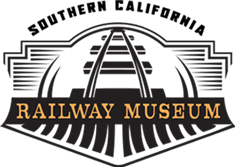Diesel Service Report, February 10, 2022
SF560 Restoration Project
Yesterday, the locomotive was started and run back and forth between Carbarn 7 and Carbarn 4 to test all systems and make sure nothing was wrong. Then Richard Berk and Carson King took the locomotive to the mainline and ran it up to Perris and back at normal operating speeds. No problems were found. This was a very import event for the refurbishment project. It gives us the assurance that the project can continue to the end and be a functional locomotive for the museum.
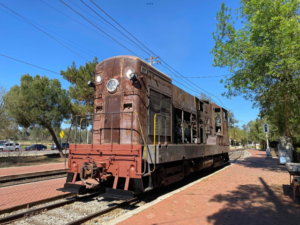 This picture shows the locomotive on the main line during the testing. Of course, the hood and engine compartment doors are still off. That will facilitate the additional extensive cleaning that is still planned.
This picture shows the locomotive on the main line during the testing. Of course, the hood and engine compartment doors are still off. That will facilitate the additional extensive cleaning that is still planned.
There were a couple of goals for the mainline testing. The first was to prove that the plain bearing axle brasses were properly seated to the axles and the temperatures of the brasses were all equal. After the operation, the brasses were all equal in temperature. Probably in the low 80-degree range. That is perfect.
The second, and even more important aspect of the test was to see if oil would be spitting out the exhaust stack. It wasn’t. Before the restoration project began, the engine would spit copious amounts of oil out the stack and spray everything around, especially downwind. Now, there is no oil spitting. Of course a longer duration of operation will be required to ensure that the oil spitting won’t come back.
Fairbanks Morse engines are notorious for spitting oil out the stack. We knew that at the beginning of the project and did almost everything we could to solve the problem. That meant cleaning the total exhaust system. And its lucky we did. The snubbers (mufflers) drains were totally plugged with burnt carbon and the exhaust manifolds severely restricted. What that meant was that any liquid oil coming out of the engine cylinders, was puddled in the exhaust manifold, then blown as a liquid into the snubbers, where it would be atomized by the exhaust gasses. That atomized oil was then shot out the top of the exhaust stack.
With the clean exhaust manifolds and snubbers, that loose liquid oil goes directly into the snubbers and drains out the bottom into collection pipes that Carl Pickus installed. It appears that about a quart of loose oil is collected in a few hours of running and after the engine is shut down. That oil is then drained after the engine is through running.
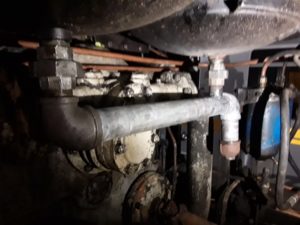 The best and perfect answer of course would be to stop loose oil coming out of piston cylinder areas into the exhaust manifold. That would entail new rings and liners, and then the problem still wouldn’t be solved because loose oil drains past the upper piston rings down onto the lower piston when the engine is shut down after running. We don’t have the money for new piston rings and liners so opted for a solution that deals with the liquid oil and prevents it from blowing out the stack. So far it appears to work. This picture shows the snubber drains plumbed together. Carl installed a valve in the piping so the collection pipes can easily be drained.
The best and perfect answer of course would be to stop loose oil coming out of piston cylinder areas into the exhaust manifold. That would entail new rings and liners, and then the problem still wouldn’t be solved because loose oil drains past the upper piston rings down onto the lower piston when the engine is shut down after running. We don’t have the money for new piston rings and liners so opted for a solution that deals with the liquid oil and prevents it from blowing out the stack. So far it appears to work. This picture shows the snubber drains plumbed together. Carl installed a valve in the piping so the collection pipes can easily be drained.
In the last report we mentioned that we had a good chance of buying used injector nozzles that were removed from an operational engine. That procurement has happened and we now have 20 spare injector nozzles to work with. It would have cost about $36,000 to upgrade to 12 modern injectors. We paid $750 for 20 used replacements. We know most of them are in excellent condition. Richard and John Salvini will test them and pick the best 12 out of the 30+ that we now own. 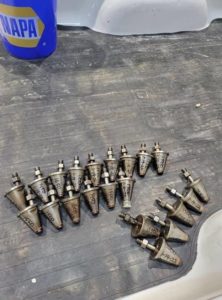 This picture shows some of the used ones, Running Take Outs (RTO) that we bought. This should provide spare injectors for the life of the locomotive.
This picture shows some of the used ones, Running Take Outs (RTO) that we bought. This should provide spare injectors for the life of the locomotive.
As mentioned previously, the hood on the locomotive was severely damaged when the locomotive was used in a Texas scrap yard for 17 years. Carl took the hood home and cut out the damaged area and installed a new piece of sheet metal. But before he could do that, he had to use the three roller sheet metal bender at the museum to prebend the new sheet into the correct shape. After the new sheet was installed, he repaired one of the exhaust stacks that was also crushed. The hood is ready to go back on the locomotive once additional cleaned is finished in the engine compartment. 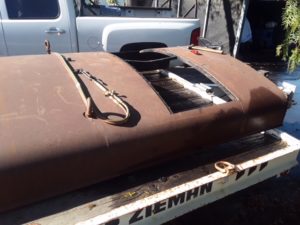
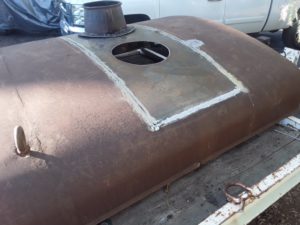
Bob Bray and Tim Johnson have started cleaning the radiator compartment. Carl had vacuumed a lot of loose rust and dirt out of there a few weeks ago. Tim and Bob then went in with a pressure washer and removed a lot more of the debris. There are still a few days of work left in that area. Initially there was no evidence of how water could drain from that compartment. They found the drain hole up near the nose door of the radiator compartment. Now that drainpipe must be cleaned for free flow of water.
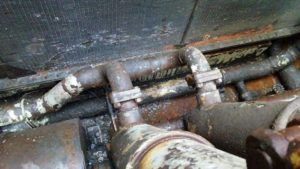
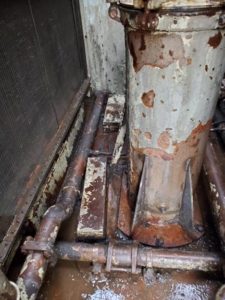 Over the past number of months, Tom Platten has continued to needle gun the accessible portions of the trucks, stairwells, handrails, and side skirts. However, when the time comes to paint the locomotive, all surfaces will have to be sanded down to remove remaining paint and mill scale.
Over the past number of months, Tom Platten has continued to needle gun the accessible portions of the trucks, stairwells, handrails, and side skirts. However, when the time comes to paint the locomotive, all surfaces will have to be sanded down to remove remaining paint and mill scale.
When we first started the project, we knew that the cooling system was extremely rusty. When the exhaust manifolds were removed and cut open, large chunks of rust were in the cooling jackets. The main pipe that fills the engine with coolant from the expansion tank, was totally filled with rust and had to be cut open to clean it out. A 3.5” crossover pipe that connects one of the radiator assemblies to the output of the engine cooling system, was about 75% clogged with rust. That pipe had rusted through in a number of spots. A portion of that pipe was cut out and replaced. Of course, that leaves a big question regarding how much rust migrated into the upper headers on the radiators and plugged up flues. There is no easy way to know that.
Our near term approach will be to operate the engine and see if it overheats. An infrared gun was used on the radiators to see if any of the flues were totally plugged. All indications were that the radiators were uniformly hot from one end to the other so no apparent clogging flues are evident.
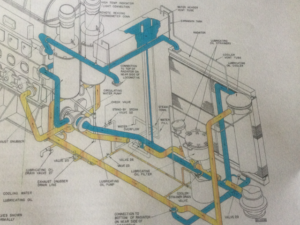 During operation yesterday, the engine warmed up to 180 degrees with the shutters closed. Once that temperature was reached, the shutters opened and the cooling fan came on. And the temperature stayed stable.
During operation yesterday, the engine warmed up to 180 degrees with the shutters closed. Once that temperature was reached, the shutters opened and the cooling fan came on. And the temperature stayed stable.
Vent lines in the cooing system were opened to ensure that water was coming out of them. If water was coming out, that meant there were no major air locks in the radiator and oil cooler plumbing. That all checked out fine. This is a diagram of all of that plumbing.
The near-term tasks will be to test and select the best 12 injectors and install them. And take compression readings during that process. Once that is done, the engine will be started again to check for exhaust smoke. Hopefully the good injectors will clear up the slight amount of exhaust smoke that is seen at idle RPM now. Then the engine will be connected to the load bank for a final power test. The intent is to load it to about 80% of its rated horsepower and let it run at that level for an hour or so until the temperatures stabilize. That will also help burn off any residual oil that is still on or in the exhaust system components. That will be the final planned load test during the restoration. The previous load test was stopped early because rubber drain hoses on the snubbers were beginning to melt.
Approximately the first week of April, the trucks will be removed from under the locomotive. The trucks will be inspected, cleaned, and painted. New brake cylinder cups be installed before the trucks are put back under the locomotive. While the trucks are out, the underneath of the locomotive will be inspected and cleaned.
After the trucks are reinstalled, new window glass will be installed and the painting of the locomotive will begin.
– Dave Althaus
